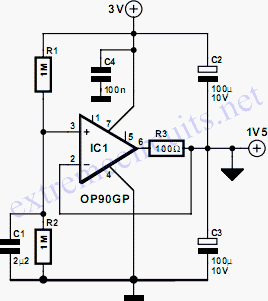Home » Circuits
3V Supply Splitter
Many modern circuits tend to work from a single supply voltage of 3V. But often they need a virtual earth at half the supply voltage for efficient operation. The splitter shown in the diagram bisects the supply voltage with a high-resistance potential divider, R1-R2, and buffers the resulting 1.5 V line with an op amp. Since the op amp used is not a fast type, the output is decoupled by capacitive divider C2-C3. This ensures that the impedance of the virtual earth point remains low over a wide frequency band. Because the potential at the junction C2-C3-R3 is fed back to the inverting input of IC1, the circuit becomes a standard voltage follower. Resistor R3 ensures that the regulation remains stable. The circuit can regulate ±2mA without any difficulties. Because of the low current drawn by IC1, and the high resistance of R1 and R2, the overall current drain is low. In the absence of a load, it was 13µA in the prototype, of which 1.5µA flows through R1-R2. Finally, since IC1 can operate from a voltage as low as 1.6V, the splitter will remain fully operational when the battery nears the end of its charge or life.
Resistor R3 ensures that the regulation remains stable. The circuit can regulate ±2mA without any difficulties. Because of the low current drawn by IC1, and the high resistance of R1 and R2, the overall current drain is low. In the absence of a load, it was 13µA in the prototype, of which 1.5µA flows through R1-R2. Finally, since IC1 can operate from a voltage as low as 1.6V, the splitter will remain fully operational when the battery nears the end of its charge or life.
